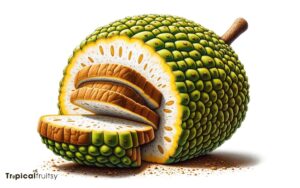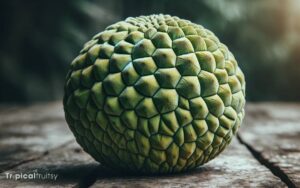What Is a Breadfruit Tree? Explained!
The Breadfruit Tree, or Artocarpus altilis, is a tropical perennial plant belonging to the mulberry and jackfruit family. It is native to the South Pacific and has been introduced to other tropical areas.
This tree is treasured for its bountiful harvest of starchy fruits, which serve as a key food source in numerous tropical regions.
The breadfruit is nutritionally rich in carbohydrates, dietary fiber, vitamins, and minerals, making it an integral part of local diets.
Breadfruit trees are characterized by:
- Large, lobed leaves
- Round fruits with a bumpy surface
- High carbohydrate content
They offer several agricultural benefits such as:
- Easy cultivation
- High fruit yield
- Importance in traditional cultures
Breadfruit trees are environmentally beneficial because they: – Enhance food security – Integrate into sustainable agroforestry systems
The rising global interest in alternative food sources positions the breadfruit tree as a significant player in future farming initiatives.
Breadfruit trees symbolize a fusion of cultural heritage and potential agronomic advancement.

Key Takeaway
Key Features of Breadfruit (Artocarpus altilis)
| Feature | Description |
|---|---|
| Scientific Name | Artocarpus altilis |
| Family | Moraceae (mulberry and jackfruit family) |
| Origin | South Pacific |
| Fruit Type | Starchy, large, round, green with a textured skin |
| Leaf Description | Large, lobed leaves |
| Nutritional Value | High in carbohydrates, dietary fiber, vitamins, and minerals |
| Agricultural Benefits | Easy to grow, high yield per tree |
| Environmental Impact | Supports food security, suitable for sustainable agroforestry |
| Cultural Significance | Integral to traditions and diets in many tropical societies |
The Breadfruit Tree Origin

The domestication of the breadfruit tree traces back to the tropical regions of New Guinea, where it has been cultivated for thousands of years before spreading throughout the vast expanse of Oceania.
Scientific analysis reveals that the species Artocarpus altilis has undergone selective breeding to enhance its yield and fruit quality.
Genetic studies indicate a complex pattern of domestication involving multiple genotypes, suggesting ancient agriculturalists recognized and exploited the tree’s propensity for vegetative propagation.
This mode of reproduction allowed for the perpetuation of desirable traits, which facilitated its spread across the Pacific Islands.
The historical significance of this tree’s domestication lies in its critical role in the sustenance of Polynesian societies, its cultural importance, and its impact on the diffusion of agrarian practices across the region.
Botanical Characteristics
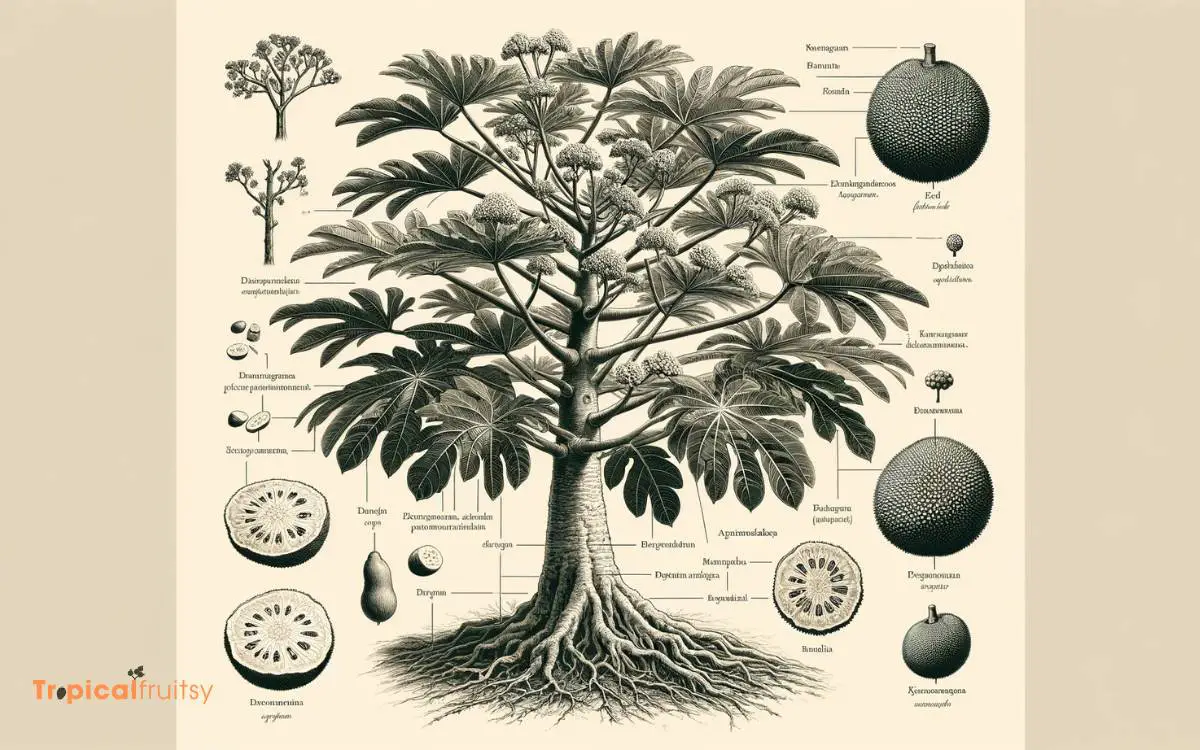
The botanical characteristics of the breadfruit tree, Artocarpus altilis, exhibit a range of morphological traits that reflect its adaptability to various environments.
The leaves of this species are deeply lobed with a leathery texture, contributing to its distinctive appearance and physiological resilience.
Analyzing the fruit morphology and growth habits provides insight into the tree’s reproductive strategies and ecological significance within its native and introduced ranges.
Leaf Shape, Texture
Each broad, deeply cut leaf of the breadfruit tree exhibits a leathery texture and can span up to 60 centimeters in length, contributing to the tree’s distinctive tropical foliage.
The leaves are pinnately lobed, often displaying a glossy upper surface with a duller and somewhat paler underside.
The venation is prominently pinnate, with lateral veins branching out symmetrically from the midrib, further accentuating the leaf’s intricate morphology.
This robust leaf structure not only performs essential photosynthetic functions but also plays a pivotal role in the tree’s transpiration process, aiding in water regulation and gas exchange.
Fruit Morphology
Numerous spherical to oblong breadfruit specimens adorn the tree, each ranging from 15 to 30 centimeters in diameter, with a green to yellow-brown skin and a fibrous, starchy interior rich in nutrients.
The botanical characteristics of these fruits are noteworthy:
- The skin texture can range from smooth to rough, with irregular patterns of reticulation, depending on the variety.
- Inside, the flesh is cream-colored and divided into segments by a core of inedible, fibrous material.
- Seeds are present in some cultivars, embedded within the flesh, while others are seedless, a trait desirable for culinary uses.
Analyzing the morphology of breadfruit is essential to understand its role in ecosystems and agriculture. This understanding seamlessly leads to an exploration of the growth habits of the breadfruit tree.
Growth Habits
While the fruit’s morphology is integral to its identification, the breadfruit tree’s growth habits further reflect its adaptability and significance in tropical agroforestry.
Artocarpus altilis, commonly known as the breadfruit tree, exhibits vigorous growth, reaching heights of 15 to 30 meters in its native and introduced ranges.
Its broad, evergreen leaves, deeply cut into pinnate lobes, contribute to its high photosynthetic efficiency.
The species thrives in well-drained, fertile soils, displaying a preference for a humid, equatorial climate with ample rainfall.
As a primarily allogamous plant, it relies on both self-pollination and cross-pollination facilitated by various vectors, including wind and insects.
This reproductive plasticity ensures genetic diversity and resilience, making the breadfruit a cornerstone species in many permaculture systems.
Understanding the tree’s growth habits provides insight into its role within ecosystems and paves the way to discussing its nutritional profile.
Nutritional Profile
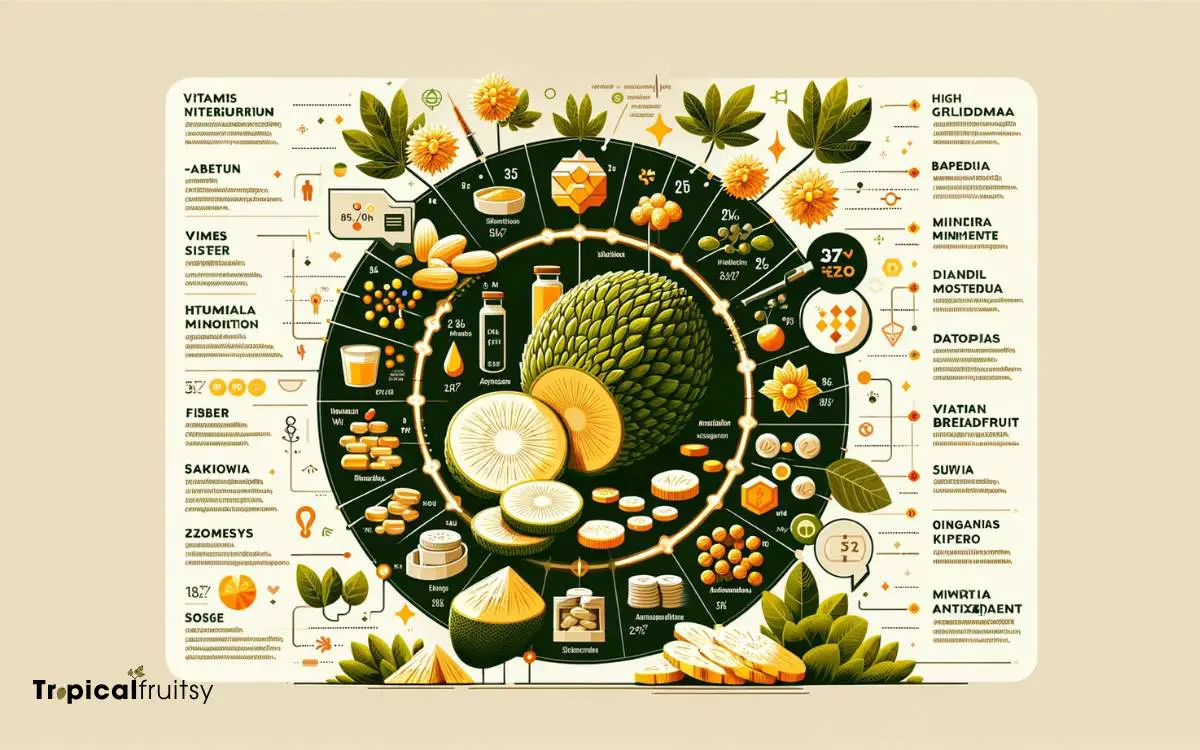
The breadfruit tree yields a starchy fruit that is rich in carbohydrates, dietary fiber, vitamins, and minerals, contributing significantly to the nutritional needs of tropical regions where it is cultivated.
A single serving of breadfruit provides a substantial portion of the dietary energy requirements, primarily sourced from its complex carbohydrate content.
- Carbohydrates: Predominantly composed of starch, breadfruit is an excellent energy source, with the ripeness of the fruit influencing its glycemic index.
- Vitamins & Minerals: It is a good source of vitamin C, thiamine (B1), and potassium, facilitating various bodily functions including immune response, enzyme reactions, and electrolyte balance.
- Dietary Fiber: The presence of fiber aids in digestion and can help regulate blood sugar levels, contributing to overall gastrointestinal health.
Analyzing the fruit’s compositional data reveals its potential as a food security crop, capable of addressing macronutrient and micronutrient deficiencies in populations reliant on subsistence agriculture.
Culinary Uses Worldwide

The Breadfruit tree (Artocarpus altilis), while native to the Pacific Islands, has found its culinary applications permeating diverse cultures globally.
Traditional recipes often exploit the fruit’s starchy content and textural properties, serving as both a staple and a substitute for other carbohydrate sources in various regional diets.
Contemporary global culinary adaptations have integrated breadfruit into a multitude of culinary contexts, reflecting its versatility and potential as a sustainable food resource in the face of increasing global food security challenges.
Traditional Recipes
We can explore a variety of traditional recipes that showcase the versatility of breadfruit as a staple ingredient in cuisines around the globe.
Breadfruit’s starchy texture and unique flavor profile make it a fitting substitute for other starches and a distinctive element in various dishes.
Analyzing its culinary applications, we note that breadfruit can be:
- Roasted or baked, which enhances its natural sweetness and allows it to develop a fluffy interior and a crispy exterior.
- Transformed into a gluten-free flour that is rich in fiber and can be used in baking or to thicken sauces.
- Used in traditional stews and curries, where its absorbent flesh takes on the flavors of the accompanying spices and liquids, making it a satisfying and nutritious addition to meals.
Each culinary application underscores breadfruit’s role in food security and its potential to contribute to sustainable agricultural practices.
Global Culinary Adaptations
Building on its versatile role in traditional recipes, breadfruit is utilized globally in a myriad of culinary adaptations, from the Pacific Islands to the Caribbean, reflecting its adaptability to various cultural tastes and cooking methods.
Scientific analysis reveals that breadfruit’s starchy composition and textural properties lend it to substitutions for potatoes and other tubers.
When immature, its enzymatic profile imparts a neutral flavor, making it an excellent canvas for spices and seasonings.
As it ripens, the fruit’s natural sugars caramelize upon heating, offering a sweet taste suitable for desserts.
Its nutritional value, particularly its high vitamin C and dietary fiber content, coupled with its low-fat profile, contributes to its popularity in health-conscious cuisines.
Thus, breadfruit’s integration into global gastronomy is not only culturally significant but nutritionally advantageous.
Cultural Significance
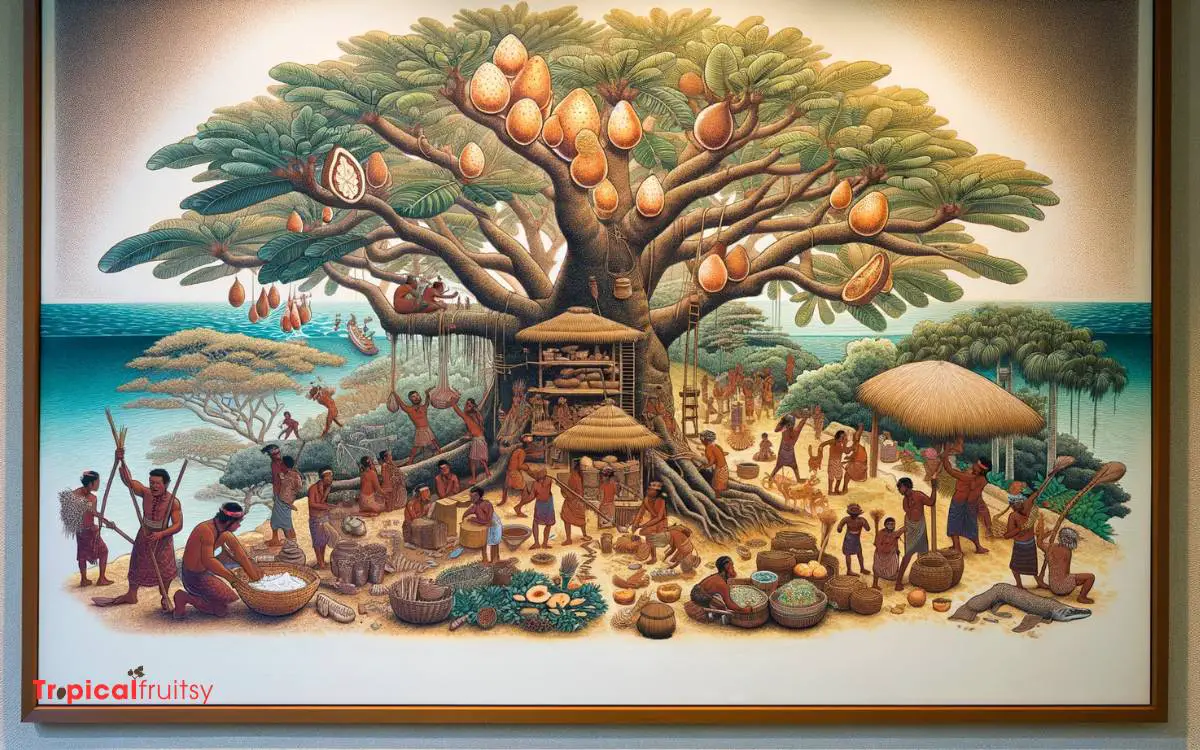
Breadfruit trees hold a deep-rooted place in the cultural tapestry of many tropical regions, where they are interwoven with local traditions, economies, and culinary practices.
This species, Artocarpus altilis, has been a staple in these areas for centuries, if not millennia. Its prevalence can be attributed to its multifaceted role within these societies.
In an analytical overview, the cultural significance of breadfruit can be segmented into the following:
- Myth and Lore: Revered in many cultures, breadfruit often appears in myths and legends as a symbol of abundance and life.
- Economic Impact: As a subsistence crop, breadfruit contributes significantly to local economies, reducing food insecurity and providing a source of income.
- Culinary Heritage: The versatility of breadfruit in cuisine reflects its integration into the cultural identity, with traditional recipes passed down through generations.
Agricultural Advantages
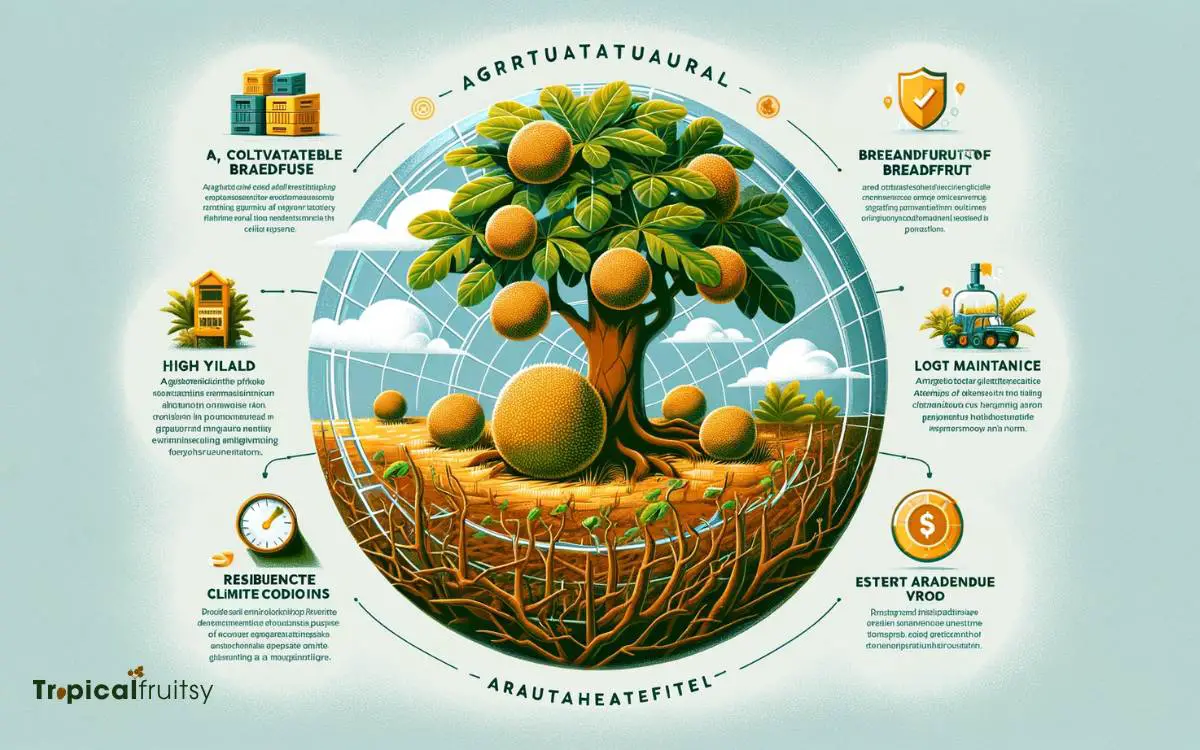
Transitioning from its cultural roots, the breadfruit tree offers a range of agricultural advantages including its low maintenance requirements and high yield potential.
The tree is remarkably resilient, thriving in a variety of soil conditions, from sandy to heavy clay substrates, and is able to withstand periods of drought once established.
Its extensive root system stabilizes soil, reducing erosion and improving soil quality over time.
Scientific analysis reveals that breadfruit trees have a commendable productivity rate, with a mature tree capable of producing up to 200 fruits per season.
This yield is particularly significant when considering the tree’s minimal need for fertilizers or pesticides, positioning it as a sustainable and economically viable crop for food security in tropical regions.
Environmental Impact

The breadfruit tree has a notable environmental impact by sequestering a considerable amount of carbon dioxide throughout its lifespan.
As a tropical perennial, it plays a significant role in the carbon cycle, contributing to carbon storage in biomass and soil.
The scientific analysis of its environmental benefits reveals several key points:
- Carbon Sequestration: Breadfruit trees absorb CO2, transforming it into biomass and helping mitigate climate change.
- Soil Enhancement: Their extensive root systems prevent soil erosion and improve soil quality through leaf litter decomposition.
- Biodiversity Support: Providing habitat and food for a range of species, breadfruit trees enhance local biodiversity.
Understanding these impacts is crucial for evaluating the breadfruit tree’s role in ecological conservation and climate change mitigation strategies.
Future Prospects and Challenges

As we consider the potential of the breadfruit tree in global agriculture, several challenges and opportunities lie ahead that must be navigated with care and strategic planning.
To harness its full potential, agronomists and scientists are tasked with optimizing cultivation techniques to increase yield and disease resistance.
Genetic diversity must be maintained to mitigate against the monoculture risks that can lead to widespread crop failure.
Additionally, there is a need to develop robust distribution networks to ensure that breadfruit can reach markets effectively and sustainably.
The integration of breadfruit into existing agricultural systems presents a socioeconomic challenge, requiring educational initiatives to promote its acceptance.
Overcoming these hurdles is critical to realizing the breadfruit tree’s role in food security and agricultural sustainability on a global scale.
What Are the Different Uses of Breadfruit From Different Types?
There are various types of breadfruit varieties used for different purposes. Some are better for frying, while others are more suitable for stewing. Some are used for making desserts, and others are consumed when they are ripe. Different types of breadfruit varieties are versatile and can be utilized in many delicious ways.
Where Do Breadfruit Trees Grow

Breadfruit trees (Artocarpus altilis) are tropical and subtropical fruit-bearing trees that thrive in regions with warm, humid climates. They are native to the South Pacific and are grown in various tropical countries around the world.
Here are some key regions and conditions where breadfruit trees typically grow:
- South Pacific Islands: Breadfruit trees are native to the South Pacific, including islands like Tahiti, Fiji, Samoa, and Tonga. These regions provide the ideal climate for breadfruit cultivation, with consistent warmth and humidity.
- Southeast Asia: Breadfruit trees are also grown in Southeast Asian countries like Indonesia, Malaysia, and the Philippines, where the tropical climate and fertile soil support their growth.
- Caribbean: Breadfruit trees have been introduced and cultivated in many Caribbean islands, including Jamaica, Haiti, Trinidad and Tobago, and Puerto Rico. They have become an important staple crop in the region.
- Central and South America: In countries with tropical and subtropical climates, such as Brazil, Costa Rica, and Colombia, breadfruit trees can be found in certain regions.
- Africa: Breadfruit trees have been introduced to some African countries with suitable climates, including Ghana, Nigeria, and Cameroon.
- Hawaii: Breadfruit trees were brought to Hawaii centuries ago, and they are now an integral part of Hawaiian agriculture and cuisine. Hawaii’s tropical climate is conducive to breadfruit cultivation.
- India: In the southern regions of India, particularly in Kerala and Tamil Nadu, breadfruit trees can be found due to the warm and humid conditions.
Breadfruit trees thrive in areas with the following conditions:
- Warm Temperatures: Breadfruit trees require consistently warm temperatures, ideally between 70°F to 85°F (21°C to 30°C). They do not tolerate frost or extended periods of cold weather.
- High Humidity: These trees prefer high humidity levels, which are common in tropical regions. Adequate moisture in the air helps promote healthy growth and fruit production.
- Well-Drained Soil: Breadfruit trees grow best in well-drained, fertile soil with good organic content. They prefer slightly acidic to neutral soil conditions.
- Plenty of Rainfall: While they can tolerate short dry spells, breadfruit trees do best with consistent rainfall throughout the year.
Breadfruit is a valuable source of food in many of these regions, and it has been introduced to other tropical and subtropical areas as well. Its starchy fruits are used in various culinary applications, making it an important staple crop in many parts of the world.
Conclusion
The breadfruit tree stands not merely as a botanical entity but as an allegory for sustenance and ecological harmony.
Its rich nutritional profile, diverse culinary applications, and cultural resonance weave a tale of a species that offers both food security and environmental benefits.
The challenges it faces, including climate change and genetic diversity, call for a concerted effort to safeguard its future. Thus, the breadfruit tree epitomizes a beacon of hope in the quest for sustainable food systems.




